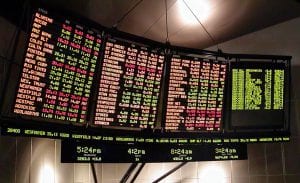
Dow Jones Trends: Embracing Sharp Corrections
Updated Dec 5, 2023
In their disarray and fear, the masses are often found on the wrong side of the market trends. This is particularly evident in their response to market corrections and crashes. However, these market events should not be feared but embraced as they present unique opportunities for savvy investors.
During periods of economic uncertainty, such as the COVID-19 pandemic or the aftermath of the post-presidential election, American households have been observed to save considerable sums of cash. According to research by Morgan Stanley economist Ellen Zentner, US consumers held an astounding $12.5 trillion from April through July 2020. This equates to 13.5 months of the $600-a-week supplemental unemployment insurance benefit that lapsed on July 31, 2020. This significant amount of cash indicates a heightened state of anxiety among the masses, which could eventually lead to a surge in market activity once the fear subsides and optimism takes hold.
The Dow Jones Industrial Average, a vital indicator of the U.S. stock market’s performance, has experienced several sharp corrections and crashes throughout history. Various factors, including economic recessions, changes in monetary policy, and financial crises, often trigger these events. However, they also present opportunities for investors who understand the market’s cyclical nature.
For instance, during the financial crisis of 2008, the Dow Jones experienced a significant drop, but this was followed by a prolonged period of growth. Investors who recognized this as a buying opportunity and acted accordingly would have seen substantial returns on their investments in the following years.
Similarly, the Dow Jones and the NASDAQ both experienced sharp corrections in March 2020 due to the onset of the COVID-19 pandemic. However, they have since recovered and reached new all-time highs, demonstrating the resilience of the market and the profit potential even in the face of significant downturns.
Moreover, despite the disruptive moments in history, the number of high-propensity business applications (businesses likely to succeed) surged year over year by 45% as of September 2020. This indicates that momentum is building up behind the scenes, and a new wave of growth could be on the horizon.
Impact of Sharp Corrections on Investor Behavior:
When the masses and experts are nervous, Tactical Investors should celebrate, for opportunity is always close at hand.
Sharp corrections in the Dow Jones Industrial Average can significantly influence investor behaviour, often leading to a heightened state of fear or euphoria. These emotional responses can, in turn, drive market trends and create opportunities for savvy investors.
When a sharp correction occurs, many investors, particularly those who are less experienced or who do not have a clear investment strategy, may panic and sell their stocks to avoid further losses. This behaviour can exacerbate the market decline and create a self-fulfilling prophecy of a market crash. This phenomenon was observed during the financial crisis 2008, where fear-driven selling contributed to a sharp drop in the Dow Jones.
On the other hand, sharp corrections can also lead to euphoria among some investors, particularly those who view the correction as a buying opportunity. These investors, often called contrarian investors, go against the crowd by buying stocks when prices are low and selling when prices are high. This strategy can be profitable, especially during periods of market volatility.
However, it’s important to note that various other factors, including the overall economic environment, changes in monetary policy, and investor confidence in the market, can also influence investor behaviour during sharp corrections. For instance, during the COVID-19 pandemic, many investors were affected by the unprecedented economic uncertainty and the aggressive monetary policy response from central banks. This led to a rapid recovery in the Dow Jones and the NASDAQ after the initial market crash in March 2020.
Moreover, behavioural finance studies suggest that investor behaviour during sharp corrections can often be irrational, driven by cognitive biases and emotions rather than an objective analysis of market fundamentals. For instance, investors may overreact to negative news, leading to excessive selling and overshooting the market correction. Alternatively, they may be overly optimistic during market recoveries, leading to excessive buying and the creation of asset bubbles.
Navigating Dow Jones Trends: Seizing Opportunities Amid Market Corrections
Market corrections, often viewed cautiously, hold hidden prospects for savvy investors. These downturns provide a window to acquire quality stocks at discounted rates, offering the potential for substantial returns as the market rebounds.
Examining historical patterns reveals that aftermarket corrections, growth typically follows. The 2008 financial crisis witnessed a significant drop in the Dow Jones Industrial Average, but intelligent investors recognising the potential for gains during the recovery phase reaped substantial returns in subsequent years.
Similarly, the COVID-19 pandemic triggered sharp corrections in the Dow Jones and NASDAQ in March 2020. However, reasonable recovery strategies and unprecedented policy responses steered these indices to new highs.
In periods of market volatility, investors can refine their strategies. This may involve identifying undervalued stocks, diversifying portfolios, or capitalizing on trends accelerated by events like the pandemic, such as the technology sector’s boom due to remote work and digital transformation.
Market corrections also open avenues for strategic asset allocation. Investors can rebalance portfolios by purchasing undervalued assets and selling surged ones. This approach helps maintain the desired risk level and potentially boosts long-term returns.
A clear understanding of market fundamentals and a disciplined investment approach are crucial to capitalise on these opportunities. Investors must assess risks and rewards objectively, steering clear of decisions driven by fear or greed.
In summary, while market corrections may unsettle, they concurrently unveil unique investment prospects. Armed with an awareness of market cycles and a disciplined approach, investors can navigate volatility and potentially profit from Dow Jones trends during these challenging times.
Conclusion
In conclusion, embracing the ebb and flow of Dow Jones trends, particularly during sharp corrections, can be a strategic move for savvy investors. Though initially met with disarray and fear among the masses, market corrections and crashes unveil unique opportunities for those who can discern the potential amidst the chaos.
Examining historical instances, such as the 2008 financial crisis and the sharp corrections induced by the COVID-19 pandemic, highlights the market’s cyclical nature. Intelligent investors, recognizing these downturns as buying opportunities, have historically reaped substantial returns during subsequent periods of growth.
Moreover, the impact of sharp corrections on investor behaviour underscores the importance of understanding the emotional responses that can drive market trends. Fear-driven selling and euphoria-driven buying are common reactions, often fueled by cognitive biases and emotions rather than a rational analysis of market fundamentals.
Navigating these trends requires a disciplined approach and a clear understanding of market fundamentals. Investors can refine their strategies by identifying undervalued stocks, diversifying portfolios, and capitalizing on emerging trends accelerated by external events. Strategic asset allocation, including rebalancing portfolios during market downturns, can help maintain the desired risk level and enhance long-term returns.
In summary, while market corrections may initially unsettle, they concurrently unveil unique investment prospects. With an awareness of market cycles, a disciplined approach, and an understanding of investor behaviour, individuals can navigate volatility and potentially profit from Dow Jones trends during these challenging times.
Delectable Articles for the Inquisitive Reader
What Economic Recovery? Most Americans Lack $1000 In Savings
Federal Reserve Interest Rate: Dangers & Benefits of Negative Rates

Why Are Interest Rates So Low: Coronavirus That’s Why
CAT Stock Price Projections And Future Trends
Why own gold in uncertain times: Protection From Disaster
HD stock quote And future price trends
Valeant Shares Slump

End Of Bull Market: Masses Worry Higher Rates Will Kill This Bull
Why Global Warming Is A Hoax & How Oil Giants Are Feeling The Heat
Nuclear Waste Management Market
Commodities Increased in April
Chinese Renminbi bullish long term outlook or Demise
Netherlands to Ban Gasoline-Powered Cars By 2025
Fossil Fuel Divestment Trends gain momentum
Tyrant Erdogan seizes six churches
Sentiment Investing: Mass Psychology Holds the Key


